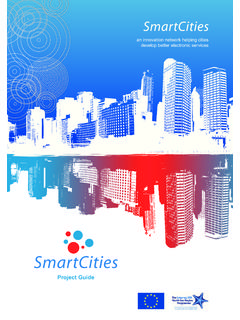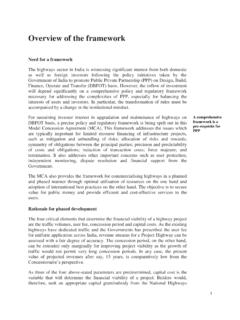Transcription of Co-design in Smart Cities
1 Co-design in Smart Cities1Co-designin Smart CitiesA guide for municipalities from Smart CitiesCo- design in Smart Cities2 Chapter 1 Introducing Co-design 03 Chapter 2 Co-design and the citizen 06 Chapter 3 Co-design within Smart Cities 09 Working with colleagues: Horizontal Co-design 10 Working with stakeholders: Vertical Co-design 10 Chapter 4 Co-design in Smart Cities partners 12 Building Co-design into services: Kristiansand 12Co- design through online engagement: Leiedal 17 Customer Journey Mapping: Edinburgh 20 Chapter 5 Contexts for Co-design 22 Finding the customer: Segmentation and customer insight 22 Finding the problem: Using consultants and gathering data 24Co- design and design thinking 26 Chapter 6 Summary & Conclusions 29 Chapter 7 Acknowledgements 30 Chapter 8 Further reading 31 design skills 31 References 31 Chapter 9 Annex: Tools & techniques 33 ContentsCo- design in Smart Cities31. Introducing Co-designCo- design describes the process of bringing stakeholders into the service design process.
2 This can start modestly for instance an ICT department may work to change its relationship with front line service delivery staff through to citizen-led service re/ design . At the heart of the approach is a move towards user-led process design , possibly also leading to a user-led approach to the delivery of services. This type of Co-design could be seen as part of a broader shift towards citizens and professional staff working together to co-produce services in report brings together the different experiences and perspectives of Smart Cities partners who have used different forms of Co-design , and links this with the findings from an evaluation of Co-design in Smart Cities that was carried out by Edinburgh Napier University in 2011. Starting with an overview of definitions of Co-design , it includes in depth examples of the different approaches to Co-design that were taken by different Smart Cities partners, and gives examples of the of the context in which Co-design works.
3 It also places Co-design in the wider context of service improvement efforts, including design thinking, segmentation and customer insight. We also describe examples of what we call horizontal Co-design where organisations learn from their peers, or work together with their peers to design new their nature, government services are complex and have to be delivered to all eligible citizens: involving a random selection of citizens or a self selected group in service design could lead to contradictory ideas, or to badly targeted services. This is a challenge faced by all approaches to public service development. In solving this dilemma, Smart Cities partners have found segmentation and customer insight useful in helping to efficiently prioritise and target groups, for instance in deciding where to start with the Co-design process. This report touches on how Cities can take advantage of the detailed demographic data built up by commercial companies Experian s MOSAIC data for example to compare predictions of service use against how they are actually used, and to identify areas where service provision needs to be reconsidered.
4 Another Co-design approach is to use surveys to better understand your customers and how they can be grouped together, and this report includes a description of survey work by Smart Cities Belgian partners MEMORI and Leiedal in the Kortrijk area of West Flanders. In our municipal policy plan local youth are indicated as an important target group. Therefore we will open a separate youth desk in the town hall But what problems to does the local youth see in their lives? Can you help to solve them? Co-design in Smart Cities4 The customer journey mapping process can combine segmentation and customer insight techniques with business process improvement work. It takes on board service customers experiences and then works to improve them, an approach which fits well with Co-design . This report summarises the City of Edinburgh council s experience with customer journey mapping (which is covered in more detail in the separate Smart Cities report on Customer Journey Mapping available at ).
5 Involving citizens in the design process creates significant challenges in collecting ideas and moving them into action. This report includes examples of the challenges that Leiedal faced in combining web-based online idea collection with efforts to make concrete changes to local environments and to show citizens how their ideas were actually making administrative processes change. Kristiansand in Norway provides an example of a country where many of the elements of Co-design have been incorporated into planning decisions for some time, even before the internet became a routinely-used tool. This report includes three examples that make the benefits of Co-design approaches clear not just for service users, but for staff and the whole thinking provides a useful range of techniques for bringing together citizens (as users) and municipal staff (as providers) to work to identify the problems that need to be solved - avoiding being trapped by pre-defined solutions that may never really be report provides useful practical background information for municipalities and other public sector organisations that are considering incorporating aspects of Co-design into their service development.
6 Co-design in Smart About the Smart Cities projectSmart Cities is an innovation network made up of fifteen government and academic partners from six countries that is working to improve the development and take-up of e-services and e-government across the North Sea Region of Europe. Project partners are improving e-service- delivery by rethinking the basics of service delivery , by changing their innovation methodology, by transferring their best practices to other project partners, and by working with academic and research partners. I ve been working here for 20 years, I know what people want and need. Are you saying what you want to do?Public services need to adapt to the needs of citizens. Often new e-services are technology-initiated, but Smart Cities start with the user. Sociology, marketing and economic science have a lot to offer to the developers of e-services but this means bringing a range of data sources together to develop accurate profiles of target customer groups.
7 The local governments and municipalities in the Smart Cities project have used a wide range of geographical, transactional, demographic and survey data to better understand citizen s needs and to re-engineer services for their communities. This has allowed partners to identify and use the most appropriate service channels for different target groups and to proactively provide services that will meet their needs. When combined with Co-design approaches, this will allow local government to use a strong mix of information and established best practices to better understand their customers and to identify the most appropriate channels for service delivery . The Smart Cities project has published a number of other research reports and guides they are referred to in the text where relevant, and a full list can be found at the end of this in Smart Cities62. Co-design and the citizenCo- design emphasises engagement by those responsible for delivery of a service or product with stakeholders in general, and with the end user/customer/citizen in particular.
8 The Smart Cities project has taken a pragmatic approach to the meaning of Co-design , starting from a simple ideal:Activity where the users of the planned new system actively collaborate in (a) defining what the system should do (problem definition), (b) the development process and (c) acceptance of the are many (possibly conflicting) stakeholders, goals, perspectives and interests involved in service development; the aim of Co-design is to create a route that allows all to make constructive contributions, and it does not start with the assumption that any stakeholder is more important than any other. Co-design is more than just simple user testing: stakeholders need to have an active role in the design and implementation processes. In the commercial world, Co-design is more common in organisations with a relatively high level of new product development. It is generally initiated by the service provider as part of the development of niche markets, and can and can be done with user-friendly user-friendly toolkits.
9 This requires the maintenance of long term relationships with customers, rather than mass-market short-term transactions. For governments, one objective of Co-design can be the empowerment of citizens: B2 Cit (Business/government to citizen) Co-design strategies differ from others in that they are not either provider, or customer-focussed. They are user-centric Co-design strategy: strategies, where collaboration is not based on the notion of a customer, but of a citizen who participates in the in Smart Cities7Co- design can be seen in the wider context of the co-production of services, where citizens continue to have active roles in delivering a service once the design stage is complete. This is best summarised in the following table from the NESTA report on co-production (Boyle and Harris, 2009):Relation of Co-design to co-productionResponsibility for design of servicesProfessionals as sole service planner Professionals and service users/community as co-plannersNo professional input into service planning Professionals as sole service deliverersTraditional professional service provisionProfessional service provision but users/communities involved in planning and co-designProfessionals as sole service deliverersProfessionals and users/communities as co-deliverersUser co- delivery of professionally designed services Full co-productionUser/community delivery of services with little formal/ professionalUsers/communities as sole deliverersUser/community delivery of professionally planned servicesUser/community delivery of co-planned or co-designed servicesSelf-organised community provisionIn this model, whether Co-design is facilitating the development of professional or user-led services.
10 It requires that professionals and users are both involved as partners in the planning/ design are four aspects of Co-design :1. Participation: Co-design is collaborative. The collaborative nature of the process is enhanced and extended all of the participants by several of its other features. There is a great deal of transparency involved in Co-design : all participants are aware of the design methodology, its inputs and outputs, its goals and current status, It is designing with people, not merely for people. This high level of participation requires a continuity of participants, to ensure the development of a close working relationship. The breadth of input from all parties is wide-ranging, ensuring a multiplicity of viewpoints and building wider community relationships between those for delivery of servicesCo- design in Smart Cities82. Development: Co-design is a developmental process. It involves the exchange of information and expertise on both the subject of the design process and the process itself.











